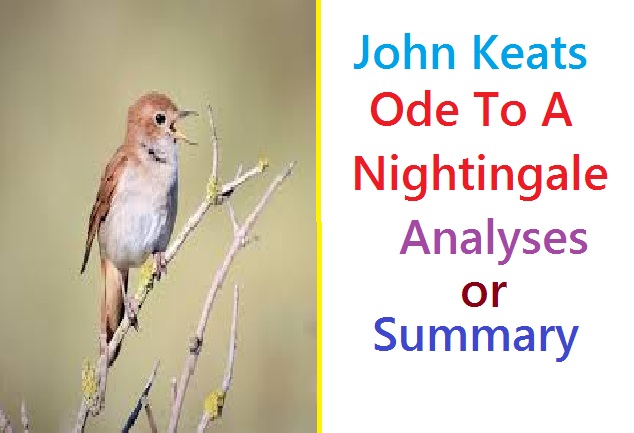Ode to a Nightingale by John Keats is one of the best lyric poems in English literature. This poem is so much fantastic that it was first published in “Annals of the Fine Arts” in July of the same year. Referred by Critics of time as “the longest and most personal of the odes”.
Table of Contents
John Keats Negative Capability
The poem descries Keats journey into the state of Negative Capability The poem explores the themes of nature, transience and mortality, the later being the most personal to Keats. This poem has also made a direct reference to the death in 1818 of his brother, Tom.
Ode to a Nightingale by John Keats is divided into eight stanzas each rhyming as aa,ab,bc,cd. It is as like as the rhyming pattern of a sonnet of ‘Shakespearean’ or ‘Petrarchan’. The poet starts like a gloomy mood. Textual reference can be included here in the following to clear the idea:
“My heart aches and a drowsy numbness pains
My sense as though of Hemlock I had drunk”.
This song has made the poet intoxicated in the poem Ode to a Nightingale by John Keats . It seems he has drink Hemlock or dived in the Lethe. In this stanza the poet has also given an account of the dwelling place of the Nightingale. In the third stanza the poet represents himself as an escapist. He thinks that world is full of sorrow, suffering and anxiety.

Read More: Michael by William Wordsworth
In the fourth stanza the poet want to make a flight to the Nightingale’s world which is full of ideal beauty. He wants to go the world of ideal beauty by the help of poetry like in the following lines:
“Not charioted by Bacchus and his pards
But on the viewless wings of Poesy”
John Keats Pictorial Quality
Fifth stanza in Ode to a Nightingale by John Keats is remarkable for the delicate pictorial quality. Sixth stanza is noteworthy because in this stanza the poet has depicted the vivid influence of the sweet song of the bird. The poet is even ready to die while enjoying the song. In the seven stanza the poet has made a contrast between the perpetually of the song and the mortality of human beings. We are subjective to decay while the song of Nightingale will remain influential forever. The eight stanza is remarkable for here the poet represents himself as a realist. Such a way:
“Forlorn! The very word is like a bell
To toll me back from thee to my sole self
Adie”
The song of the Nightingale represents beauty and the beauty is ideal beauty that never fades. The poet says that nothing is permanent in this cruel world/ Bit the bird will sing and give same pleasure of the same rate in all time. The poet says that the particular bird may die but their species will continue with singing. No hungry generation can vanish this beautiful creature. In this way the poet tries to immortalize the bird. It is the eternal spirit of beauty. He says:
“Thou wast not born for death, immortal bird!”
Sensuousness in John Keats Poem
If we talk about the sensuousness, the speech of our sensuous organs will come. In this regard Ode to a Nightingale by John Keats, is mentionable for its sensuousness for which John Keats is to be said a great sensuous poet in English literature. His description of nature is so vivid that it seems to us that we are in the nature. His description of flower is so delicate that it seems that we are smelling flower. In the second stanza the poet has a very sensuous pictures. He says in the following ways:
“Testing of Flora and the country green”
Keats lover for the mythology has been focused in this poem. At the very outset of this poem we find that the poet has mentioned the name of river Lethe, the river of underworld in where anyone bath he or she may forget his past life. Even the legend of the Nightingale has been chosen from the Greek mythology. The name of Bacchus, god of wine is also mentioned in the fourth stanza. Thus Keats Hellenism is conspicuous in this poem.
Above all we can say that the poem Ode to a Nightingale by John Keats is the high water mark in romantic poetry. Keats thinks of the lose of the physical world and regards himself dead, he uses an abrupt, almost brutal world for it as a ‘Sod’ over which the Nightingale signs. Now we may conclude our discussion with the opinion of Robert Bridges who says “I can not same an English poem of the same length which contains so much beauty as this ode”.
Read More Literary Writings:
WH Auden the shield of Achilles Critical Analysis
Critical Discussion On the poem Ode To A Nightingale
Character of satan in paradise lost book 1 | Satan as a renaissance hero in paradise lost
To His Coy Mistress Analysis And Summary By Andrew Marvell
Somebody Once Told Me The World Was Macaroni Lyrics
The Love Song of J. Alfred Prufrock represents conflict of modern man
Robert Browning as a writer of dramatic monologue
Tennyson as a representative poet of his age or Victorian Period


